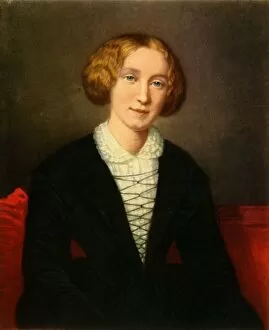Marian Lewes Collection
Marian Lewes, also known by her pen name George Eliot, was a prominent English novelist in the 19th century
All Professionally Made to Order for Quick Shipping
Marian Lewes, also known by her pen name George Eliot, was a prominent English novelist in the 19th century. Born in 1819 as Mary Ann Evans, she adopted the pseudonym to ensure her works were taken seriously in a male-dominated literary world. With her insightful and realistic portrayals of characters and society, Marian revolutionized the Victorian novel. In this captivating photograph from around 1850, we see an image herself. The black-and-white portrait captures her intellectual gaze and determined expression, and is a testament to her dedication to literature and her commitment to challenging societal norms. Another artwork that pays homage to George Eliot is "Tessa at Home" from her novel Romola published between 1862-63. Painted by Frederic Leighton in 1923, it depicts Tessa peacefully reading at home—a scene reminiscent of Eliot's own love for literature. One cannot discuss George Eliot without mentioning some of her notable works such as "Fedalma. " Created by George Fuller between 1883-1884, this painting transports us into one of Eliot's narratives with its rich colors and intricate details. The artist Frederick Adcock takes us on a tour through two different houses associated with George Eliot—her residence in Chelsea and Wimbledon Park—in his paintings from 1912. These images provide glimpses into the spaces where she lived and wrote, offering insight into the environment that inspired some of literature's greatest works. A fascinating artifact related to Marian Lewes is an original manuscript page from Adam Bede dated March 23rd, 1859. This handwritten document showcases not only Eliot's meticulous attention to detail but also provides a tangible connection to the creative process behind one of her most beloved novels. G Sidney Hunt immortalizes George Eliot through his striking portrait capturing both strength and vulnerability—an accurate representation of this remarkable writer who defied conventions and challenged societal expectations.

















